
Although there are over a thousand species of the most beautiful birds with mohawks, we shall be highlighting about 30 of them for your pleasure.
When we say mohawk, a lot of us will often associate it with punk rock stars.
You know the kind of hairstyle where every part of the head is shaved except for a narrow strip of hair that runs from the forehead to the middle, down to the back.
But such a cool hairstyle is not peculiar to rock stars only or even humans.
You will be amazed to know that some birds actually have these mohawks as well, and they rock it proudly, either for beauty or for catching the eye of females.

- Scientific name: Upupa epops
- Range: Asia, Europe, and Africa
- Diet: Omnivore
- Conservation status: Least concern
We shall begin our list with this distinctive species of bird renowned for its attractive colors that you’ll find in Asia, Europe, and parts of Africa.
You can’t possibly miss the black-and-white barred wings and the orange neck down to the crest, and also the attractive mohawk on their heads which they can’t help but flaunt.
A closer look at the top of their mohawks will reveal black tips, which draw attention during courtship display
Eurasian Hoopoe is an omnivorous bird that feeds on plants, seeds, insects, amphibians, small rodents, and reptilian animals.
They prefer open spaces where they can forage on the ground and probe the soil with their strong long, and slender beaks with powerful muscles which can allow the beak to open while inside the soil

- Scientific name: Rupicola rupicola
- Range: South America
- Diet: Omnivore
- Conservation status: Least concern
Another bird on our list distinguished for its striking bright mohawk is the South American Guianan Cock-of-the-rock.
The bright orange mohawk extends to the back, with a sharp contrast of black feathers covering the rest of the bird’s body.
While the males may be the only ones with the striking mohawk, the females aren’t lacking completely in that department as they do have a small crest on their heads.
You can find this bird species in the South American forests, where you may even spot some of them from time to time engaging in an interesting mating dance.
They can grow up to 30cm and weigh 200 to 300 grams, and fruits are their main diet.
Although, an occasional diet of insects, small lizards, and snakes is not completely off the menu of the Guianan Cock-of-the-Rock
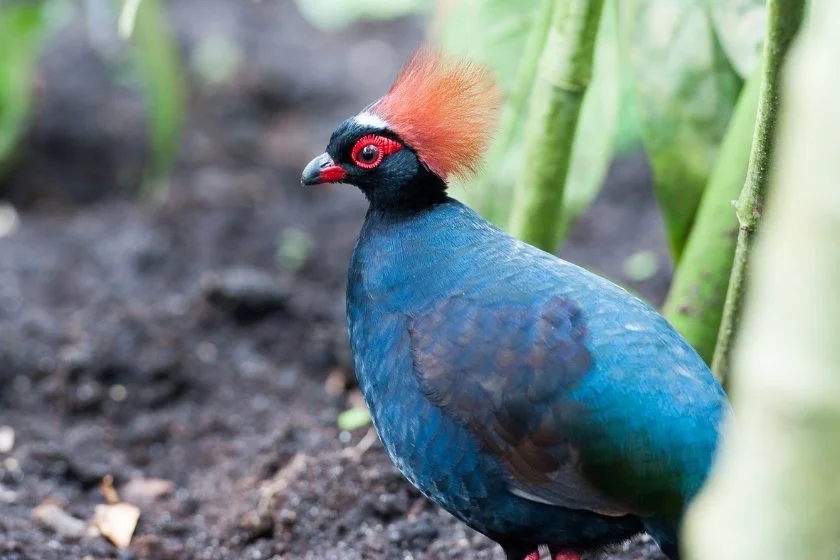
- Scientific name: Rollulus rouloul
- Range: Southern Asia
- Diet: Omnivore
- Conservation status: Near threatened
The Crested Partridge is one bird you can find in dense lowland rainforests of Central and Southern Asia, especially in countries like Thailand, Malaysia, and Borneo.
They have mohawks from their forehead down to their back. Male Crested Partridge comes in a glossy-black color, while the females have a mossy-green body and cinnamon-brown feathers.
They are quite the silent creatures as they prefer to quietly forage on wet forest grounds, making them likely to miss.
Adults Partriages can grow up to 30cm, and they are omnivorous, eating mostly fruits, snails, and insects such as large beetles, wood ants, and small animals.
Their color differentiates both sexes, but one similarity they share is the ring around their eyes.
Next, you sing the famous 12 days of Christmas song about the partridge on a pear tree, that’s the bird we are talking about.
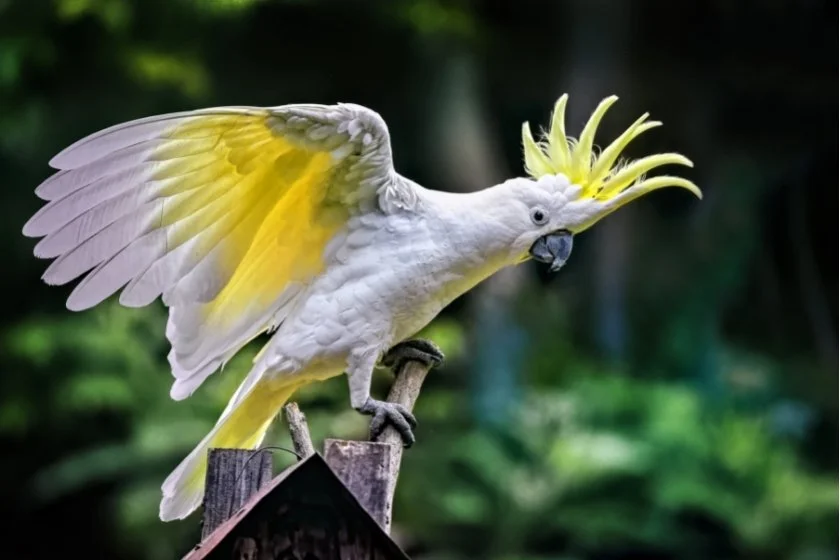
- Scientific name: Cacatua galerita
- Range: New Guinea, Australia, and Indonesia
- Diet: Herbivore
- Conservation status: Least concern
One interesting thing about the Sulphur-crested cockatoo isn’t because of its beautiful mohawk but because this bird lives up to its name.
It has a beautiful white body and yellow underbelly and prefers to live in sulfur-crested areas like Indonesia, Australia, and Papua New Guinea.
They are so beautiful that many people will often keep them as pets. This specie of Cockatoos can grow up to 30 to 40cm.
They are mostly herbivores because they feed mainly on fruits, nuts, plant roots and seeds, and insects.
Many people don’t know that the Sulphur-Crested Cockatoo is a specie of large and has a lifespan of 30 to 40 years.
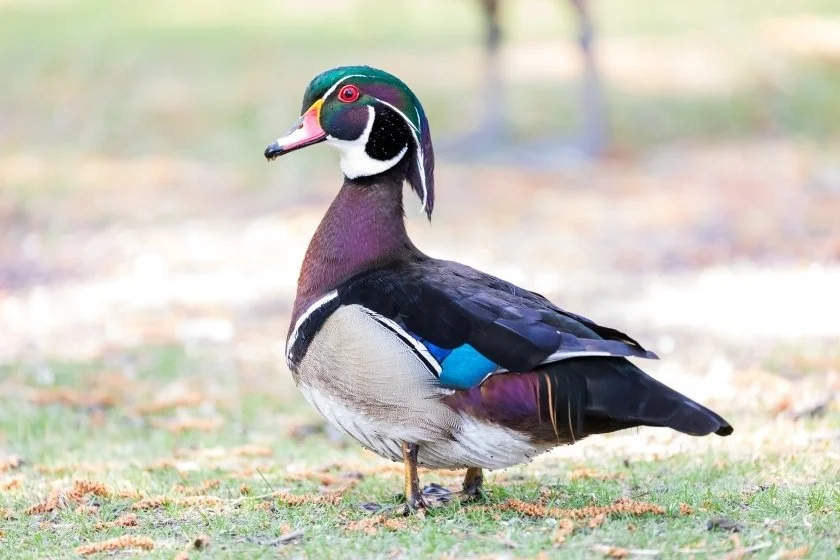
- Scientific name: Aix sponsa
- Range: North America
- Diet: Mostly herbivore
- Conservation status: Least concern
The Wood Duck is not only renowned for its mohawk in the duck family, but family it’s also one of the most colorful ducks on the planet.
You can find most of them in the North American region, where they love to dwell by making their nests in swamps and lakes and forage for food, sometimes on dry land. They can grow up to 54cm in length.
Some might assume that because of their name that this mohawk bird will likely be a wood eater.
But that isn’t the case because this bird is an omnivore that prefers nuts, seeds, berries, vegetables, and insects.
A study has shown that contrary to assumptions, these ducks also consume more animal matter
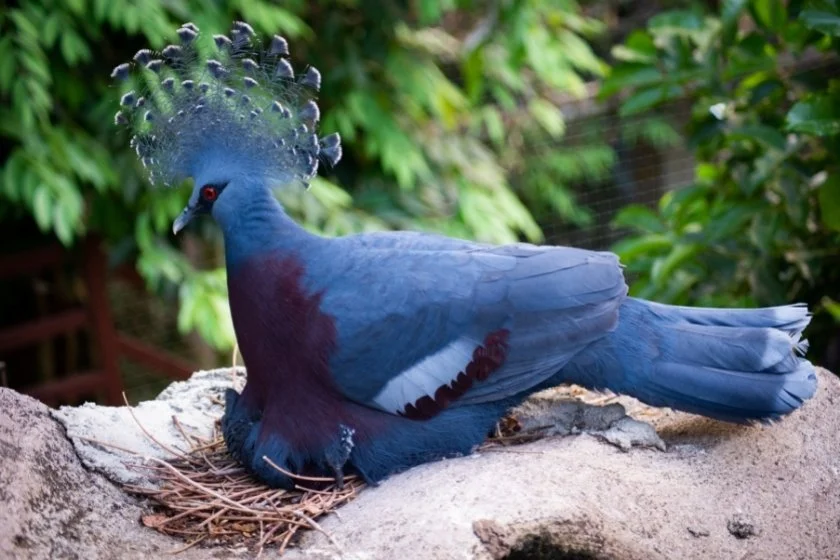
- Scientific name: Goura victoria
- Range: New Guinea
- Diet: Herbivore
- Conservation status: Near threatened
Growing up to 24 inches and weighing between 28 to 128 ounces, the Victoria-crowned pigeon is one of Mother Nature’s masterpieces.
Maybe that was why its name was inspired by the British monarch crowned Queen Victoria.
Uniquely found in the native forests of New Papua Guinea, these iconic birds are not only one of the rarest of birds, but they are also one of the largest species of birds alive today
Their iconic beauty resides in their iconic bluish-gray array of feathers, and also, another has an amazing array of colorful feathers on their head which gives them that mohawk look.
They are herbivores that depend mostly on fallen fruits, berries, seeds, and plants.
Like the characteristics of pigeons, these species can fly, and they tend to make lots of flapping noise during flight, and they have been found to live up to 30 years in captivity
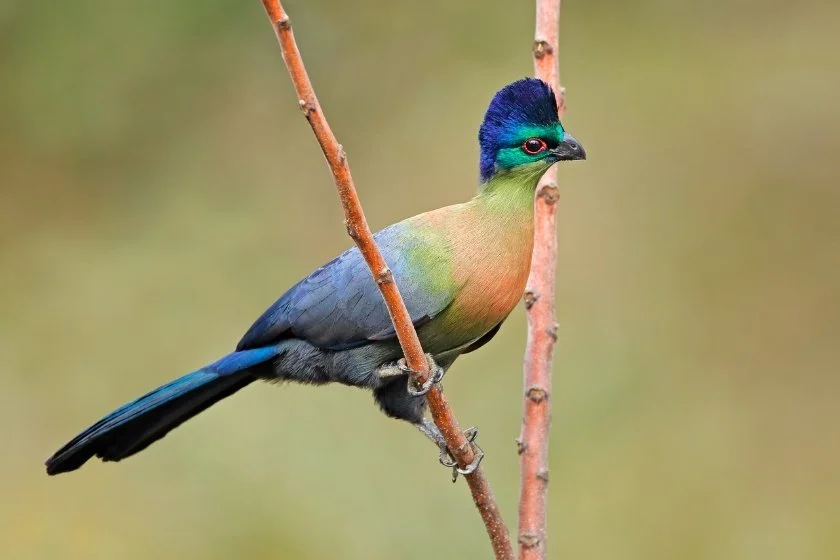
- Scientific name: Tauraco porphyreolophus
- Range: Africa
- Diet: Herbivore
- Conservation status: Least concern
The Purple-Crested Turaco is a specie of the Turaco family, and the Brazilian name for Turaco means “banana water.”
These birds can be found in Africa, even though experts have predicted that climate change may force the migration of these tropical birds to other parts in a few years.
Their body is covered in mostly blue and green colors and a cool mohawk with a fine blend of red, blue, and yellow
This species of Turaco is one that doesn’t like to feed on land and will only forage from tree branches where its main diets are fruits and fruit seeds.
In the wild, their lifespan may be shorter but in captivity, they can have a lifespan of up to 30 years.
The females are usually the biggest; with some of them weighing up to 327g, and their male counterparts weighing up to 300g
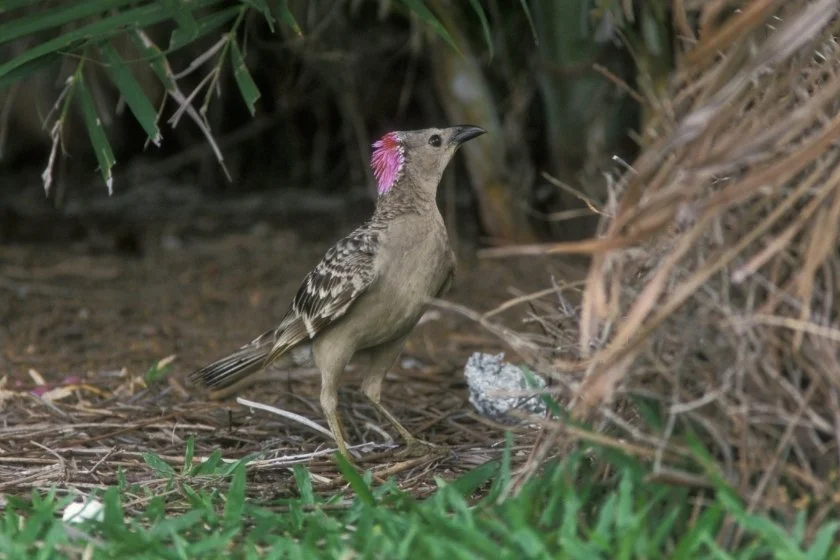
- Scientific name: Chlamydera nuchalis
- Range: Australia
- Diet: Herbivore
- Conservation status: Least concern
These birds can be found in the Northern parts of Australia, and they grow up to 35cm. Adult males can weigh 180 to 265g, while females weigh from 115 to 253gram.
Their name “Bower” is gotten from the males who design and defend an array of sticks called “bower,” which they will beautify with assorted green and white pebbles, leaves, and shells.
This structure is what they use to attract their mate. The job of the female, on the other hand, is to take care of the nest and their young
The Great Bowerbird found its name on our list because of its pretty pink mohawk on its head.
Their diets can range from fruits, seeds, vegetables, nectar, etc. Under close protection and supervision, they can live up to 30 years. Currently, there are over 18 species in the world today
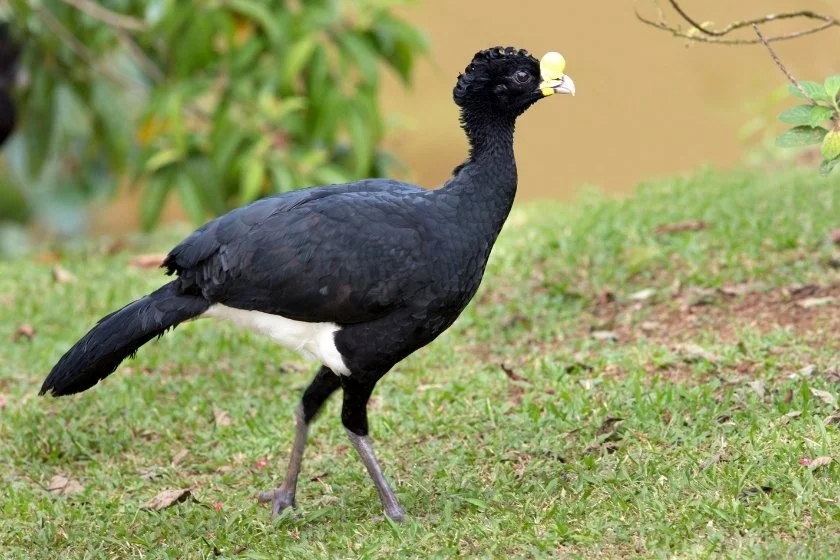
- Scientific name: Crax rubra
- Range: North America
- Diet: Omnivore
- Conservation status: Vulnerable
This beautiful specie falls under a category of large birds found in Central and Southern America, especially in Ecuador.
Fully covered in nearly glossy black with white, a contrasting white belly, and a crest of feathers on its head that gives it a mohawk look. They can weigh up to 39 inches and weigh up to 150 ounces
The Great Curassow should have been herbivores, but their non-picky nature transformed them into omnivores.
You can find them mostly on the ground foraging for fallen fruits, seeds, and berries, and if these diets prove scarce, sometimes they can eat small animals. They eat almost anything.
There used to be more of them, but now they’ve become an endangered species with only about 40,000 to 50,000 remaining population left

- Scientific name: Prionops plumatus
- Range: Africa
- Diet: Insects
- Conservation status: Least concern
Growing up to 9.8 inches and weighing 1.3 ounces, the White-crested Helmetshrike is among the distinguished birds with its mohawk appearance.
One way to identify them is through their iconic black and white plumage often found in large groups perching on trees and chirping away.
Both males and females look alike with their fluffy crests on their heads
These birds are mostly found in Africa, especially in the savannahs and subtropical wet forests.
The White-crested Helmetshrike has a well-coordinated social order where jobs are designated and coordinated by a dominant hierarchy.
During the breeding season, foraging routes are created and followed by the group

- Scientific name: Pithecophaga jefferyi
- Range: Philippines
- Diet: Carnivore
- Conservation status: Critically endangered
The list won’t be complete without naming this iconic bird that also holds the undisputed crown of the largest bird on the planet.
This top apex predator is renowned for its intimidating stare due to its blue-gray facial features, accentuated by a sharp hooked beak.
An adult can grow to over 3 feet and weigh almost 18 pounds. It is interesting to know that the size of this large apex bird doesn’t put a dent in its agility and swiftness.
They are endangered, with the IUCN listing them as one of the critically endangered species due to loss of habitat and environmental pollution. Its estimated population remains at barely less than 500 of the species left.
You can find the Philippine Eagle in highlands and old-growth forests in the Philippines and several other Islands in the country.
They generally have a long lifespan, with some reported to live up to 50 years or more.

- Scientific name: Crinifer personatus
- Range: Africa
- Diet: Herbivore
- Conservation status: Least concern
Another mohawk bird on the list is the Bare-faced go-away bird which comes from the lineage of Turaco but is a little drab in its features compared to most Turacos.
Unlike their many Turaco counterparts renowned for their colorful display, this one boasts just a bare face that is gray.
Their name comes from the loud go-away sound they make, and they have been known for their noisy behavior.
What fits them to the list is their crested mohawk which they often use to attract mates.
You can find this species of birds in African countries such as Zambia, Kenya, Rwanda, Malawi, and the Republic of Congo

- Scientific name: Baeolophus bicolor
- Range: North America (United States)
- Diet: Fruits and insects
- Conservation status: Least concern
The Tufted Titmouse is quite smallish in size, with adults growing between 5 to 6.3 inches.
Their name was gotten from the small tuft of feathers on their heads which resembles a mohawk.
These small songbirds can only be found in the United States, along open cultivated Park areas and gardens, and their favorite meal are fruits, seeds, and insects such as bees, wasps, snails, and caterpillars
This bird species has been found to predominantly reside in the woodlands of eastern United States all year round and never like to migrate elsewhere.
You can spot them in their habitats by identifying their gray and white underpants and black cap.
These cute little creatures are quite the economists, and they will occasionally store excess food in a safe place with the hopes of eating it later.

- Scientific name: Balearica regulorum
- Range: Southern Africa
- Diet: Omnivore
- Conservation status: Endangered
The Grey Crowned Crane is a large native bird of the eastern and southern African region.
You can easily identify them from their white and Grey mixture on their feathers and sometimes either red or orange patches on their heads.
Their name is gotten from the crown-like array of tufts on their heads which can resemble a mohawk.
Another interesting thing to note about the Grey Crowned Crane is their mating ritual, where they will dance around and jump fashionably to lure their mates.
These birds are omnivores and can eat almost anything from fruits, seeds, grains, insects, snakes, frogs, and even fish.
They belong to the crane family and remain one of the few species of the crane lineage that can roost on trees because of their large hind legs.
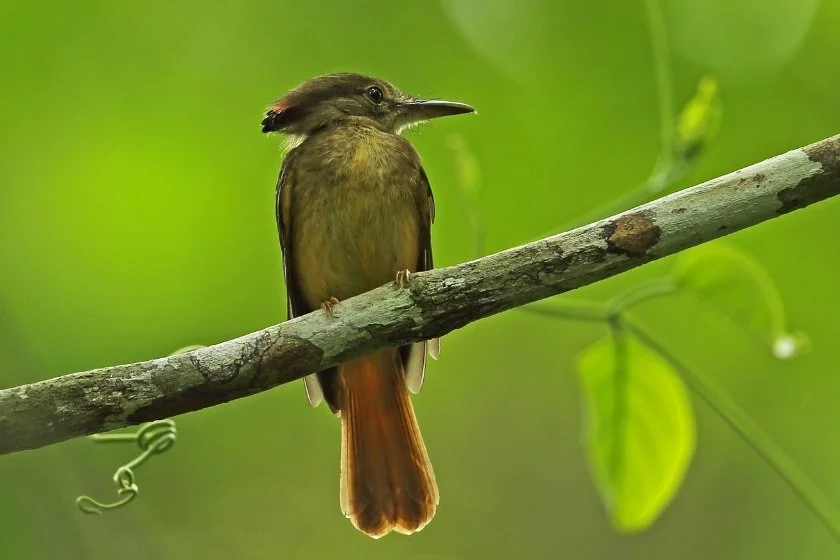
- Scientific name: Onychorhynchus
- Range: North America
- Diet: Insects
- Conservation status: Vulnerable
This one is one of nature’s finest. It has a large beautiful crest that it loves to flaunt to attract the opposite sex during mating or courtship.
Their amazing crest gives them that mohawk appearance. You can find them in the Southern and Central parts of America.
You will often see them in tropical forests at both high and low elevations as long there is easy access to water.
Adult Royal Flycatchers can grow up to 7 inches and weigh up to 1 ounce. This species is insectivorous, and they prefer to forage on insects such as grasshoppers, cicadas, ants, and dragonflies.
You can identify them in their habitat by their brown and patches of yellow or red color, depending on subspecies.
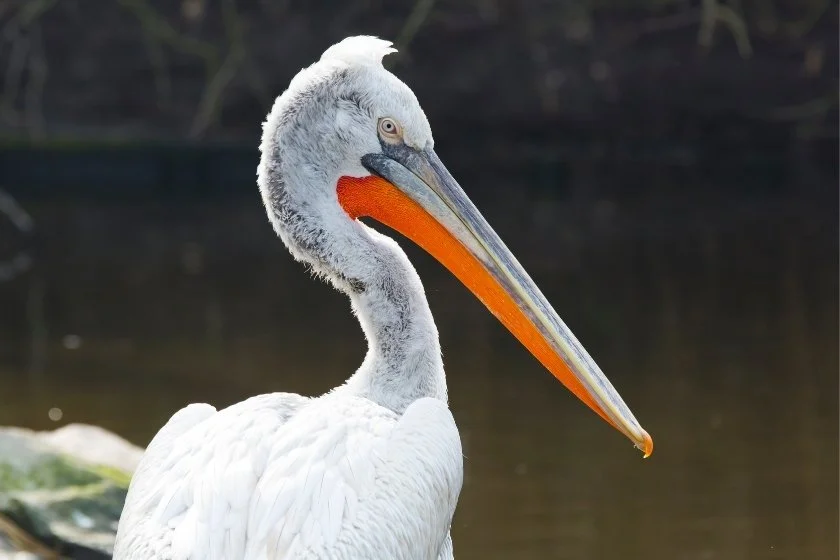
- Scientific name: Pelecanus Cruiqus
- Range: Europe and Asia
- Diet: Carnivore
- Conservation status: Vulnerable
The Dalmatian Pelican is the largest bird in the pelican family and is also listed as one of the largest flying birds on the planet.
They possess tufts on their heads which gives them that intimidating mohawk appearance among birds with mohawks. They can grow up to 6.3 feet in length and weigh between 15 to 30 pounds.
You can find them in wetlands in central Europe and southern Asia and also in the Middle East. You can spot them often traveling in groups during migration to and from their breeding areas.
They are carnivores who depend mostly on fish, carp, crustaceans, eel, and sometimes insects like beetles.
You can always identify them by their silver-white plumage and orange and gray bills. And on their heads, you can see patchy tufts that resemble that of a mohawk

- Scientific name: Chrysolophus pictus
- Range: Asia, Southern America, and Europe
- Diet: Insects and fruits
- Conservation status: Least concern
This bird species originates from China, but migration has pushed some of them to North and Southern America and Europe.
Popularly known as the rainbow pheasant in China, this bird falls into the list of birds with mohawks.
Despite their flying abilities, these birds will still like to forage on the ground for seeds, grains, and insects. They are quite large and can measure between 35 to 42 inches long.
You can differentiate both sexes by their colors, where the males have bright red and gold plumage while their female counterparts possess a duller brown plumage.
They prefer to stay in high-altitude areas, mostly in their native homeland in China.
Their average lifespan is between 6 and 7 years, but if well-taken care of, like those in captivity, they can live up to 15 or even 20 years

- Scientific name: Nymphicus hollandicus
- Range: Australia
- Diet: Frugivore
- Conservation status: Least concern
The Cockatiel is a small bird that belongs to the family of parrots, and they can be found in their natural habitat in Australia.
As parrot characteristics, the Cockatiel is reputed for its friendly nature, and it can mimic human speech. They also occupy a high position among the most popular pets in the world.
Although not all Cockatiels have a mohawk, most do, as it’s common among Cockatiels.
The ones with mohawks usually have yellow or white tufts of feathers on their heads, which gives them that mohawk look, and the rest of their body is covered in grey.
However, in captivity, some possess a mutation of over 20 colors. They have a long lifespan, with 25 years being the average lifespan an adult Cockatiel can live up to

- Scientific name: Anas platyrhynchos domesticus
- Range: South America
- Diet: Insects
- Conservation status: Least concern
The Crested Duck may not be the only bird with a mohawk, but they are among the most popular.
Perhaps because, as ducks that like to swim, flaunting their mohawk during swimming can draw quite the attention. You can find this waterfowl in places like South America.
Like it’s common with some mohawk birds, this one gets its name from the white crest of feathers on their heads.
The cool thing about their mohawk is that it can be raised or lowered at will, depending on their mood.
If the duck feels like flaunting its mohawk, it will puff it in such a way that it will make it even more prominent to draw attention.
They weigh 32 to 112 ounces and rarely live up to ten years.

- Scientific name: Cardinalis
- Range: North America
- Diet: Fruits and insects
- Conservation status: Least concern
The Northern Cardinal is one of the mohawk-wearing birds of its species that is on the list. They can be found in Central America.
This species of bird is popular for its bright red feathers. Though both sexes have red plumage, that of the males is brighter, and they have a black mask around their eyes, while that of the female is a little shadowy-brown.
One funny habit with the Northern Cardinal is that they will often attack their reflections during the breeding season in an obsessive manner to protect their territories.
Both sexes have little crests on their heads that have a mohawk appearance.
They feed on various things ranging from insects such as ants, beetles, caterpillars, spiders, flies, etc., and vegetables like wild fruits, seeds, flowers, and berries.

- Scientific name: Probosciger aterrimus
- Range: New Guinea and Australia
- Diet: Frutivore and nuts
- Conservation status: Least concern
This species is a member of the parrot family. You can find this large black parrot in its native regions, such as New Guinea and Australia.
These adorable birds are reputed for their mohawk appearance and friendly and pleasant nature in mimicking human speech.
Not only do they have the biggest beaks of any parrot, but they are also the largest cockatoos in Australia and arguably on the planet.
These birds love rhythm too much, as they would often use their large beaks to break sticks which they use for drumsticks.
As is the characteristic of parrots, the Palm Cockatoo loves to eat nuts, hard nuts, grains, fruit, and seeds. They have a pretty long lifespan, with some of them living up to 60 years.
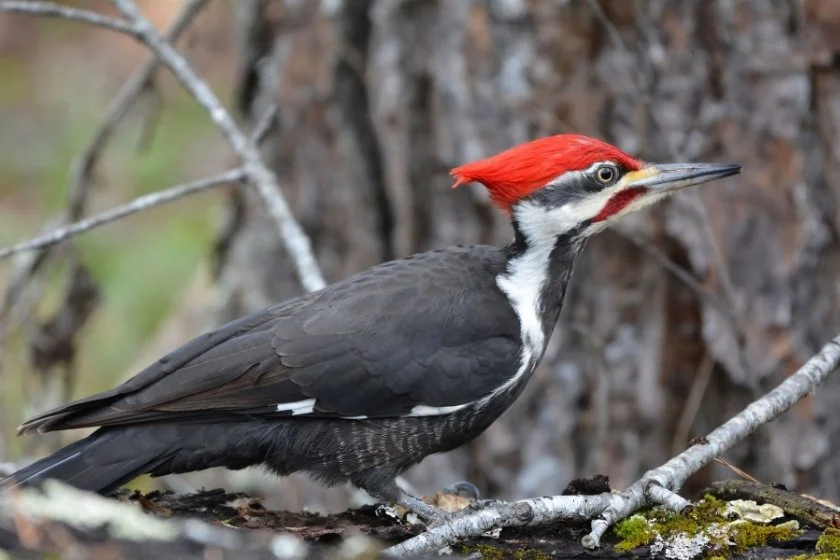
- Scientific name: Dryocopus pileatus
- Range: Canada
- Diet: Insects
- Conservation status: Not threatened
The Pileated Woodpecker is a bird of the woodpecker family and is native to North America and ranks on the list of one of the largest woodpeckers on the planet.
You can find these adorable birds in places like western Washington and Canada.
The Pileated woodpecker is adorned with beautiful white and black color and has a red crest on the head, which resembles that of a mohawk.
The underparts of the wing can be seen during flight. Both sexes of the Pileated Woodpecker can look similar, but you can still differentiate them.
The male has red stripes on their cheeks which you call a mustache, while the female has black mustaches. The average lifespan of the breed of birds is around 12 years.
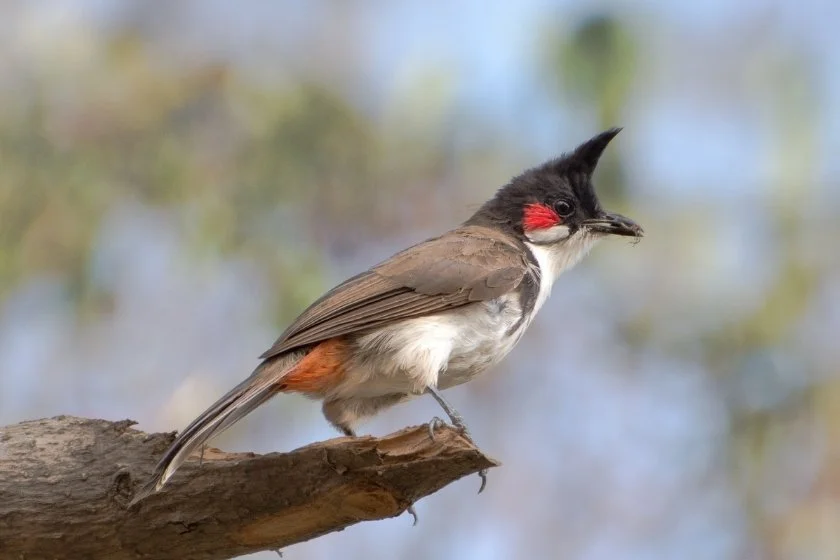
- Scientific name: Pycnonotus jocosus
- Range: Asia
- Diet: Omnivore
- Conservation status: Least concern
Please don’t allow the sound of their name to make you into thinking these cute-looking birds are tough, and they are not.
They are one of the popular pets in many Asian countries. You can also appreciate the singing nature of these small birds native to Asia. They also belong to the Old World Babbler family.
One distinguishable feature of this bird is the red streaks on its cheeks which are often confused for a mustache.
On top of its head is a spiky crest that resembles a mohawk and which is why it made the list of birds with mohawks. They love to travel in groups and prefer eating fruits and insects as their main delicacy.
The lifespan of the average Red-whiskered bulbul in the wild is 11 years, though, in captivity, they can live more than

- Scientific name: Mergus albellus
- Range: Western Europe
- Diet: Carnivore
- Conservation status: Least concern
Another bird of the duck family that found its name on the list is the Smew. This duck stands out due to its unusual plumage.
The head and back of the Smew are covered in black plumage, while its belly and breast are adorned in white.
But what qualifies it as a mohawk bird is the tufts of feathers that stands on its head in a mohawk fashion. You can find this bird in low-altitude regions in North Germany
Smews can live up to 10 years with good husbandry, and their preferred diet is fish and various insects. They can grow in length up to 17 inches and weigh up to 23 ounces.
Often, they have been spotted laying their eggs in old nests of woodpeckers. The fine blend of the Smew makes it one of the most amazing birds for good viewing.

- Scientific name: Butorides striata
- Range: Europe, Africa, Asia
- Diet: Carnivore
- Conservation status: Least concern
You can see the striped black, white and golden color on their back and wings. Perhaps that was how it got its iconic name.
You can easily find them in coastal regions in Europe, part of Africa, Asia, and Australia.
They may appear silent, but during breeding season or when they are alarmed, their loud squawking sounds are almost unmatched.
On the heads of the males, you will see their prominent mohawks. They can grow to almost 13 inches long, which is considerably small for a heron.
But you can still see the black mohawk on their heads which is what makes them stand out.

- Scientific name: Goura cristata
- Range: New Guinea
- Diet: Herbivore
- Conservation status: Vulnerable
Not all pigeons have mohawks, but the Western crowned pigeon is among the few that do, making this subspecies stand out among its family.
With an estimated population of 3500 to 15000, you can find this rare species of bird in the low rainforest of Papua New Guinea and several islands.
They are also the second largest pigeon in the world and just a little smaller than the Vitoria Crowned pigeon.
Adult Western Crowned pigeons can grow for up 28 inches in length and weigh about 2.1kg. This species is herbivores who forage on mostly fallen fruits, berries, and seeds.
Although, on rare occasions, some have been found to include small invertebrates in their meal.
What sets them apart and includes them on this list is their beautiful blue-like crest on their heads which can also pass as a mohawk.
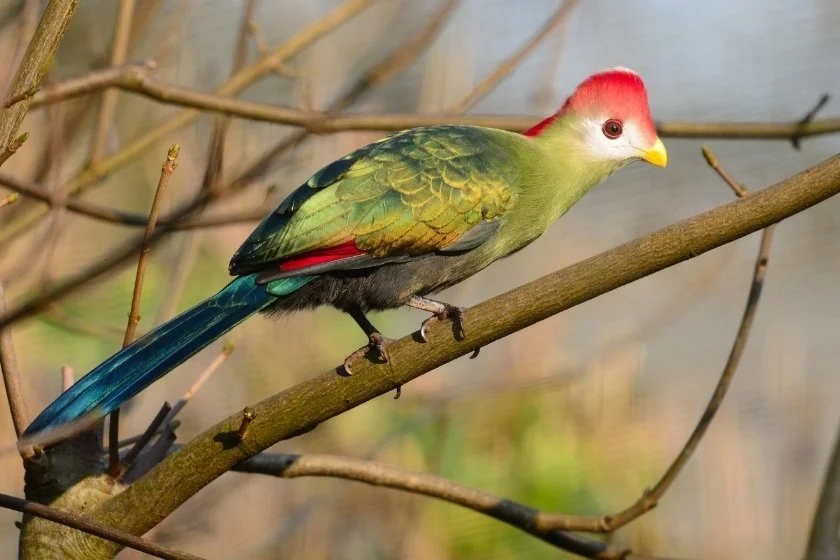
- Scientific name: Turaco erythropus
- Range: Africa
- Diet: Herbivore
- Conservation status: Least concern
This beautiful bird called the Red-crested Turaco is of the Turaco family and can be found in Africa, especially in countries like Angola.
You can see the red tufts of feathers that begin from the beak and goes all the way to the back of the head, giving it that mohawk fashion which is what makes it stand out and why it was included in our list.
They are quite the noise makers as their loud calls can often be heard from a distance.
They often go in groups, and sometimes up to 30 of them can be seen adorning a tree. They are large as adults can grow between 18 to 20 cm and weigh about 6 to 8 ounces.
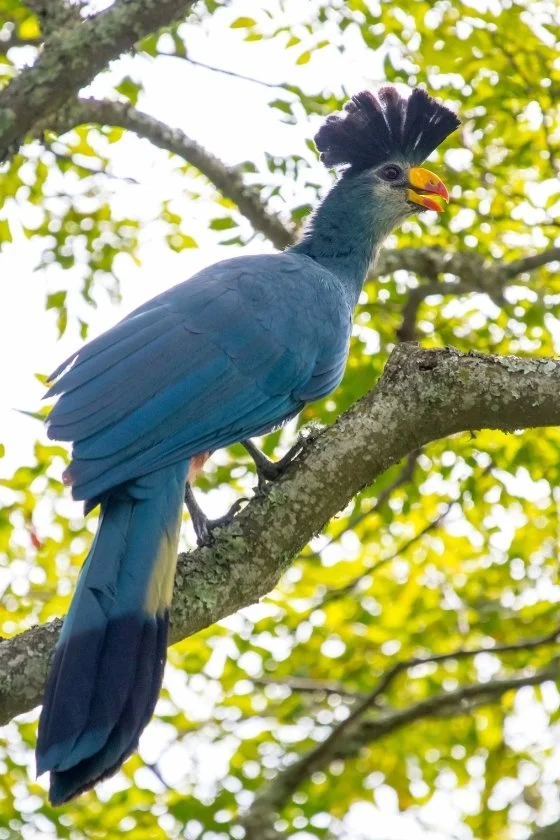
- Scientific name: Corythaeola cristata
- Range: Africa
- Diet: Herbivore
- Conservation status: Least concern
The beauty of this Turaco bird is pronounced in the blue, red, and green colors, and accentuated on its head is a tiny crest that has made the Great Blue Turaco fall into the category of birds with a mohawk.
This large bird is a native of Africa, where you will likely find them; in Central and western Africa.
The Great Blue Turaco is the largest specie of the Turaco family and can grow in length between 70 to 76cm. Sometimes they are often kept as pets in zoos for display because of their attractive colors.
They are natural herbivores who feed mostly on fruits and seeds but occasionally can be found foraging on plant matter such as leaves, flowers, and shoots.
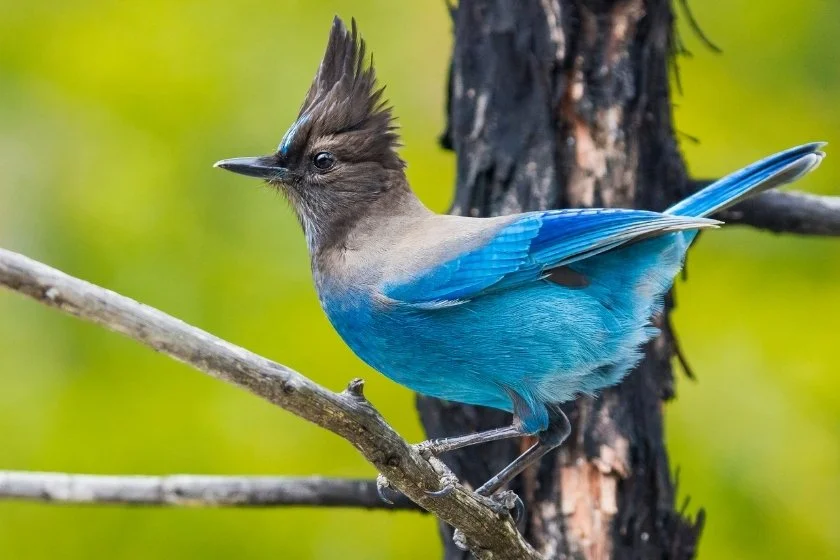
- Scientific name: Cyanocitta Stellari
- Range: America
- Diet: Omnivore
- Conservation status: Least concern
This adorable bird is of the Jay family. You can find it throughout the forests and mountainous regions of the North, and Central regions of America, including the Pacific.
They usually flock in groups and have been renowned for their agility and protectiveness against threats.
They can grow up to 13 inches and are known to be omnivorous as they prefer to eat fruits, seeds, nuts, and vegetables.
Another reputation attributed to the Steller’s Jay is their penchant for noise.
Their loud cries can be heard from far away, even in the dark, and they can even make the sounds of other birds, animals, and reptiles.
On average, the Steller’s Jay can live up to 10 years and even more while in captivity.
Mohawks on birds can be as a special adornment of beauty by nature.
It is also important to note that they have other good reasons too, such as mating, communicating, and even intimidation.
The number listed above may seem quite much, but it might surprise you that these are but a few.
There are more species of beautiful birds with mohawks out there that are distinct for their unique hairline.
Checkout other birds lists: